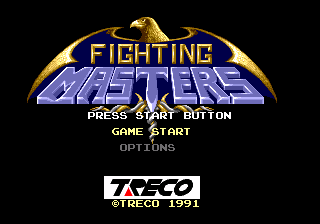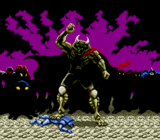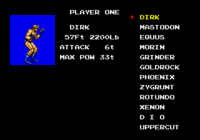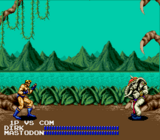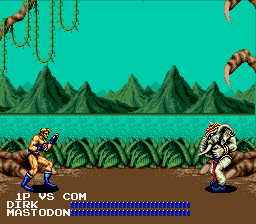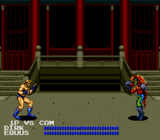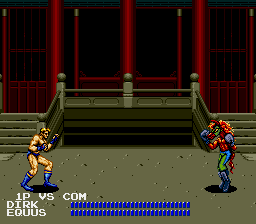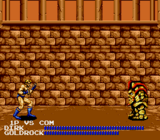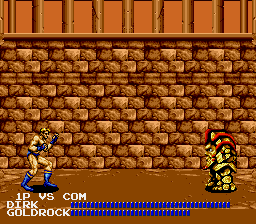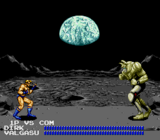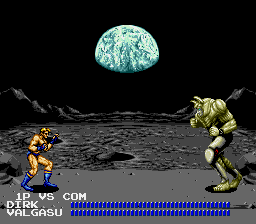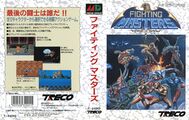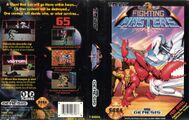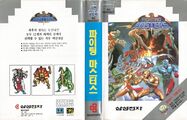Fighting Masters
From Sega Retro
| ||||||||||||||||||||
| Fighting Masters | ||||||||||||||||||||
|---|---|---|---|---|---|---|---|---|---|---|---|---|---|---|---|---|---|---|---|---|
| System(s): Sega Mega Drive | ||||||||||||||||||||
| Publisher: Treco | ||||||||||||||||||||
| Developer: Aicom, ALU | ||||||||||||||||||||
| Sound driver: SMPS Z80 | ||||||||||||||||||||
| Genre: Action[1] | ||||||||||||||||||||
| Number of players: 1-2 | ||||||||||||||||||||
|
Fighting Masters (ファイティングマスターズ) is a Sega Mega Drive fighting game developed by Aicom and ALU, and published by Treco. First released in Japan in December 1991, it was soon localized and brought to the United States the following April, and was eventually published in South Korea later in 1992.
Notable for predating the release of Capcom's highly-influential Street Fighter II, it generally received mixed reviews for its control style and limited gameplay, but has since been critically re-evaluated as an admirable early attempt at the fighting game genre.
Contents
Story
In the Japanese version, a demon lord known as Valgasu leads an underground campaign against a twelve-star galaxy to conquer it, defeating all of their fighting masters except one and enslaving them. The last fighting master must battle against the other, enslaved masters and Valgasu himself.
In the US version, an enormous red sun is about to go supernova within hours. An omnipotent race called the Primaries have the power to save one other race from extinction and holds a competition where one representative from every race competes in a tournament to the death to decide the winner.
Gameplay
The game is a fighting game with an emphasis on grappling moves. Players fight each other in one-on-one matches in small arenas enclosed by walls. The fighter who manages to deplete the health bar of the opponent wins the bout.
Fighters move with ![]() or
or ![]() . They squat with
. They squat with ![]() and jump with
and jump with ![]() . Holding jump for longer jumps higher. When jumping onto a wall, fighters automatically bounce off in the opposite direction (which can be used to escape corners). They attack with
. Holding jump for longer jumps higher. When jumping onto a wall, fighters automatically bounce off in the opposite direction (which can be used to escape corners). They attack with ![]() . There is no blocking.
. There is no blocking.
Attacking when away from the opponent does a punch or a kick. These attacks do little damage but stun the opponent for a short period of time, allowing the fighter to move in closer for a grapple. Each fighter has a different attack for when they are standing, squatting, or jumping. Every fighter can do a dive attack by pressing ![]() +
+![]() after jumping.
after jumping.
Fighters grab each other when they are in close contact (from walking or jumping into each other). While grappling, either player can break contact by pushing the D-Pad away from the opponent or perform a throw by pairing the attack or jump button with a direction. Throws do big damage, which can be further increased by throwing opponents onto the ground or against a wall. Stunned fighters can also be grabbed, which is safer since the opposing player cannot perform a throw while stunned.
Modes
In single-player mode, the player chooses from twelve playable characters and fights a match against every other character, ending with a battle against the demon lord Valgasu. The player can choose the difficulty level (Easy, Normal, or Hard) and the number of continues (3, 4, or 5).
There is also a two-player mode for matches against another human opponent (players must choose different characters) and a watch mode for viewing a fight between computer-controlled opponents.
Characters
Playable
Some of the names were changed for the North American release.
Bosses
| Valgasu | |
|---|---|
|
Species: ? Origin: ? Height: 9'6" Weight: 666 lbs. Attack: ? Max Pow: ? | |
| A monstrous, horned demon and the final boss of the game. |
Stages
There are only three stages that are used when fighting most opponents, plus an additional stage only used for the final fight with Valgasu.
History
Development
Due to the small ROM size (4 megabits), typical for its time, the game has limited animations, few backgrounds, and no voice data. But the game compensates its limitations by having 12 playable fighters.
Production credits
- CG Design: Masami Takizawa, Nao.Yuki, T Shigemura, Ashin
- Back Design: Wakatuki, N e n k o
- Title Design: Ujita, Wakatuki
- Sound: Masapi, Shioya
- Assistant Director: Ramou Kobayashi, Hajime Kusano
- Test Play: Yasuhisa Kimura, Akahoushi
- Game System: Y a z a w a, N e n k o
- Program: Y a z a w a
- Thanks: Okamura
- U.S.A. Staff: K.Adachi, N.Evangelista, R.Bell, T.Kowalewski, L.Huffman
Magazine articles
- Main article: Fighting Masters/Magazine articles.
Promotional material
- Main article: Fighting Masters/Promotional material.
Physical scans
| Sega Retro Average | ||||||||||||||||||||||||||||||||||||||||||||||||||||||||||||||||||||||||||||||||||||||||||||||||||||||||||||||||||||||||||||||||||||||
|---|---|---|---|---|---|---|---|---|---|---|---|---|---|---|---|---|---|---|---|---|---|---|---|---|---|---|---|---|---|---|---|---|---|---|---|---|---|---|---|---|---|---|---|---|---|---|---|---|---|---|---|---|---|---|---|---|---|---|---|---|---|---|---|---|---|---|---|---|---|---|---|---|---|---|---|---|---|---|---|---|---|---|---|---|---|---|---|---|---|---|---|---|---|---|---|---|---|---|---|---|---|---|---|---|---|---|---|---|---|---|---|---|---|---|---|---|---|---|---|---|---|---|---|---|---|---|---|---|---|---|---|---|---|---|
|
| 61 | |
|---|---|
| Based on 26 reviews | |
| Mega Drive, US |
|---|
Technical information
- Main article: Fighting Masters/Technical information.
References
- ↑ 1.0 1.1 https://sega.jp/history/hard/megadrive/software_l.html (Wayback Machine: 2020-07-02 23:21)
- ↑ Beep! MegaDrive, "November 1991" (JP; 1991-10-08), page 14
- ↑ Sega Visions, "May/June 1992" (US; 1992-xx-xx), page 58
- ↑ GamePro, "June 1992" (US; 1992-xx-xx), page 30
- ↑ File:Fighting Masters MD credits.pdf
- ↑ 1700 igr dlya Sega, "" (RU; 2001-xx-xx), page 81
- ↑ Beep! MegaDrive, "January 1992" (JP; 1991-12-07), page 79
- ↑ Consoles +, "Janvier 1992" (FR; 199x-xx-xx), page 30
- ↑ Console XS, "June/July 1992" (UK; 1992-04-23), page 130
- ↑ Computer & Video Games, "February 1992" (UK; 1992-01-15), page 86
- ↑ Mean Machines: The Essential Sega Guide, "" (UK; 1993-11-18), page 46
- ↑ Famitsu, "1991-12-13" (JP; 1991-11-29), page 40
- ↑ GamesMaster (UK) "Series 2, episode 4" (1992-10-22, 24:00) (+7:22)
- ↑ Games-X, "2nd-8th January 1992" (UK; 1992-01-02), page 22
- ↑ Génération 4, "Janvier 1992" (FR; 199x-xx-xx), page 141
- ↑ Hippon Super, "January 1992" (JP; 1991-12-04), page 93
- ↑ Joystick, "Janvier 1992" (FR; 199x-xx-xx), page 133
- ↑ Sega Mega Drive Advanced Gaming, "November 1992" (UK; 1992-xx-xx), page 79
- ↑ Mega Drive Fan, "February 1992" (JP; 1992-01-08), page 89
- ↑ Mega, "July 1993" (UK; 1993-06-17), page 33
- ↑ Mega, "December 1993" (UK; 1993-11-18), page 77
- ↑ Mega Action, "Christmas 1993" (UK; 1993-12-02), page 80
- ↑ MegaTech, "February 1992" (UK; 1992-01-20), page 54
- ↑ Mean Machines, "February 1992" (UK; 1992-01-27), page 88
- ↑ Mean Machines Sega, "October 1992" (UK; 1992-09-xx), page 138
- ↑ Power Play, "5/92" (DE; 1992-04-15), page 148
- ↑ Sega Pro, "February 1992" (UK; 1992-01-16), page 63
- ↑ Sega Pro, "April 1993" (UK; 1993-03-11), page 65
- ↑ Sega Saturn Magazine, "September 1995" (JP; 1995-08-08), page 86
- ↑ Tricks 16 bit, "Tricks Sega Gold 800 igr" (RU; 1998-03-20), page 75
- ↑ VideoGames & Computer Entertainment, "July 1992" (US; 1992-0x-xx), page 48
| Fighting Masters | |
|---|---|
|
Main page | Comparisons | Hidden content | Magazine articles | Video coverage | Reception | Promotional material | Region coding | Technical information | Bootlegs | |

